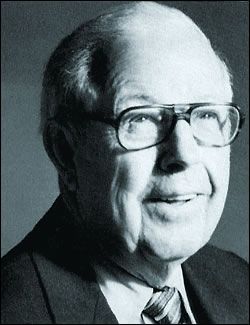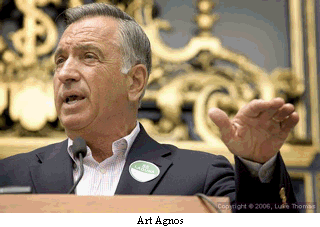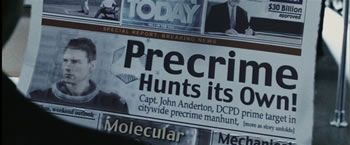The Tardy Times
GEEZER NOTES
The fishwrap crisis: 'Get outta this
business, kid, before it's too late. . . '
For more doom and gloom, see these pages:
Rise of the Freesheets
The Bronstein Era
Paper vs. Electrons
Gazoot Editorials (4)
The fishwrap crisis: 'Get outta this
business, kid, before it's too late. . . '
For more doom and gloom, see these pages:
Rise of the Freesheets
The Bronstein Era
Paper vs. Electrons
Gazoot Editorials (4)
THE LUNCHEON guests honored Gale Cook, their esteemed city editor in
the treasured past. Not until dessert did anybody express
forebodings about the future of what we retirees still venerate as the
Church of the Newspaper.
Teensy microchips have shaken our faith.
Larry D. Hatfield remembered. Will Stevens had warned us.
Nearly 40 years ago, after his customary three-martini lunch at the M&M, this distinguished elder of the press would hang up his battered fedora and light brown trenchcoat. Then he would scan the Examiner cityroom for one of the younger reporters. He would walk up politely, fingering his regimental mustache and apologizing diffidently for the interruption. And apologize again. But then he would lean over my old Underwood and offer fervent advice.
“Get outta this business, kid,” he would say, softly, with passion. “Get out before it's too late.”
We didn't.
We revered newspaper journalism. It was a calling. We were a band of impious brothers who had taken vows with a zealous devotion to the unattainable canon of dispassionate neutrality. We took notes. We interviewed. We observed. We tried.
Four decades later, WE are the apologetic elders.
Big-city newspapers are outta here.
How soon?
Pick up “The Vanishing Newspaper.” Philip Meyer has chosen 2043 as doom time. Thirty-five years? That's too optimistic. Twenty years? Probably less.
><
IN 1980, the late, great Norris Alfred experienced an editorial epiphany. He had taken two days off from trying to find new brass mats for his 1905 Linotype. The last of the 48-point Block Gathic cap roman M's had been stolen by type lice from his California Job Case. He needed spare parts for the Babcock Big Drum flat-bed press that printed his 800-circulation weekly, one
sheet at a time. Instead, he went birding on the Big Blue. The river had hypnotic appeal for the publisher-editor-printer-janitor of the Polk Progress,
where his Pulitzer Prize nomination may have been the first ever from a
depopulated farm town in south-central Nebraska. The local folks
(mostly Republicans) put up with his folksy criticisms of the Vietnam
War, for example, interspersed with essays on bird behavior. The main
draw, typical of country newspapers throughout the land, was what used
to be known as “personals.” (“The Peterson family drove to Omaha to go
shopping.”) His biggest fan was a chicken farmer who told him, “I love
your newspaper, Norris, because I can sit right down and read like hell
about people I know.”
press that printed his 800-circulation weekly, one
sheet at a time. Instead, he went birding on the Big Blue. The river had hypnotic appeal for the publisher-editor-printer-janitor of the Polk Progress,
where his Pulitzer Prize nomination may have been the first ever from a
depopulated farm town in south-central Nebraska. The local folks
(mostly Republicans) put up with his folksy criticisms of the Vietnam
War, for example, interspersed with essays on bird behavior. The main
draw, typical of country newspapers throughout the land, was what used
to be known as “personals.” (“The Peterson family drove to Omaha to go
shopping.”) His biggest fan was a chicken farmer who told him, “I love
your newspaper, Norris, because I can sit right down and read like hell
about people I know.”
As he was driving toward the Platte, Norris saw a road sign that advertised The Newspaper Museum in a nearby village. He was curious. A lifelong printer, he wheeled into town, paid $5 admission – and discovered that the attractions included an ancient Linotype, the California Job Case and a Big Drum Babcock press.
“At that point,” he wrote us, “I knew that I, too, am a print museum.”
><
Not a word about the cyberfuture of news coverage interrupted the tributes in January to Gale, now 85. To a generation of reporters, he embodied honesty, judgment, soft-spoken leadership and an appreciation of eloquent writing.
High on the ridge above El Cerrito, peering through the windows of the Mira Vista Country Club, we could see rain drench the Bay Area – the cities, big and little, where newspaper coverage of news events had helped shape public attitudes in the middle years of the 20th century. Art Agnos, San Francisco's liberal ex-mayor
and state legislator, had set up the luncheon (and picked up the tab)
in appreciation for Gale's abilities on the city desk and, later, as a
statehouse correspondent. At the table with us were Gale and his wife, Helen,
and his son, Steve, together with Gerald Adams, Jim Finefrock, Carol
Pogash, Larry Hatfield and Art's wife, Sherry.
century. Art Agnos, San Francisco's liberal ex-mayor
and state legislator, had set up the luncheon (and picked up the tab)
in appreciation for Gale's abilities on the city desk and, later, as a
statehouse correspondent. At the table with us were Gale and his wife, Helen,
and his son, Steve, together with Gerald Adams, Jim Finefrock, Carol
Pogash, Larry Hatfield and Art's wife, Sherry.
In our lifetimes, many a newspaper has come and gone, mostly gone. Typical is the résumé of Gerry Adams, a Tam High graduate who broke in at the San Rafael (now
Marin) Independent-Journal in the early 1950s. Then he moved to San
Francisco's afternoon papers – Scripps Howard’s News (killed 1956),
Hearst’s News Call-Bulletin (killed 1965) and Hearst’s Examiner (sold,
looted, orphaned, resold and eventually turned into a tabloid
freepaper, 2000). Gerry (at left) finally quit full-time work at the Chronicle,
newly acquired by Hearst, but he works one day a week on urban affairs
stories.
at the San Rafael (now
Marin) Independent-Journal in the early 1950s. Then he moved to San
Francisco's afternoon papers – Scripps Howard’s News (killed 1956),
Hearst’s News Call-Bulletin (killed 1965) and Hearst’s Examiner (sold,
looted, orphaned, resold and eventually turned into a tabloid
freepaper, 2000). Gerry (at left) finally quit full-time work at the Chronicle,
newly acquired by Hearst, but he works one day a week on urban affairs
stories.
Over the years, Gerry and the others at the table have also lamented the disappearances of the Oakland Post-Enquirer, Los Angeles Examiner, L.A. Mirror and L.A. Herald, San Diego Tribune, Richmond Independent, Berkeley Gazette, Palo Alto Times, Redwood City Tribune, San Jose News, Sacramento Union and a dozen weeklies, including the San Francisco Progress. That's more than two dozen missing Bay Area voices in the mixed choir of the Church of the Newspaper, and the news pews are as uncrowded as in St. Cecilia’s Church at morning mass on March 18.
><
ONE GLIMPSE of the unguessable future is seen in “Minority Report,” a Stephen Spielberg movie. The props include an e-paper. It’s based on the “mediatron” in a 1995 sci-fi novel by Neal Stephenson. (He may have been delighted with “homeopaper” – an individually customized video newspaper envisioned in an earlier novel by Philip K. Dick.) In the Dreamworks movie in 2002, fugitive Tom Cruise boards a subway train where he is scanned and ID’d by hidden cameras. As he tries to blend in with the crowd, he looks over the shoulder of a passenger who has unfolded a paper-thin USA Today.
“Instead of static photos and text, it’s constantly changing text, video and perhaps sound,” says an enchanted reviewer. “Think of it as a combination paper, television and Internet,
presumably wirelessly connected to a futuristic Wi-Fi. . .” Cruise can
see the headline on its flat screen: “Molecular Nano-Technology?” as
it morphs into “Breaking News!” On the updated front page is the
subway photo of Tom Cruise. To me, it’s the scariest scene in the
movie. A horror show.
combination paper, television and Internet,
presumably wirelessly connected to a futuristic Wi-Fi. . .” Cruise can
see the headline on its flat screen: “Molecular Nano-Technology?” as
it morphs into “Breaking News!” On the updated front page is the
subway photo of Tom Cruise. To me, it’s the scariest scene in the
movie. A horror show.
The date: 2054.
><
IT WON'T TAKE that long, we are told by Bay Area cartoonist Scott Adams. And nobody could be more interested, because his “Dilbert” panels run daily in more than 2,000 newspapers.
“I predict that the end of printed newspapers will happen in the time it takes for most people to upgrade their cell phones two more times,” he writes in his blog. “The iPhone, and its inevitable copycats, (let's call them iClones) are newspaper killers. When you have a web browser in your pocket, a printed newspaper is redundant. Eventually, all cell phones will have Internet browsing built in.”
OK. So he's not a certified authority. Turn instead to the Economist. Oblivious to punnery, a leader article warns, “Over the next few decades, half the rich world's newspapers will fold.”
“Newspapers are dying,” writes a worried pundit, Eric Alterman, in the New Yorker for March 31.
He quotes Bill Keller, executive editor of the New York Times: “At places where editors and publishers gather, the mood these days is funereal.”
In a cover story in The Nation on Jan. 29, 2007, John Nichols writes, “Newspapers may be the dinosaurs of America's new-media age, hulking behemoths that cost too much to prepare and distribute and that cannot seem to attract young – or even middle-aged – readers in the numbers needed to survive.”
Alterman: “Few believe that newspapers in their current printed form will survive. Newspaper companies are losing advertisers, readers, market value, and, in some cases, their sense of mission at a pace that would have been barely imaginable just four years ago.”
According to one survey, only 19 percent of Americans aged 18 to 34 ever look at a newspaper, and the average age of readers is said to be 55.
Our 30-year-old nephew: “I don't have time.”
Our 21-year-old brother-in-law: “No interest.”
Our 17-year-old daughter: “I like Facebook.”
In the class he teaches at SF State, Chronicle reporter Steve Rubenstein said only four students in 20 could identify both California senators – one from San Francisco, the other from Marin. And these students are journalism majors.
><
WE MAY still be cackling about the good old days when the last broadsheet daily comes off the last rotary press. But to read about the news of the day, we'll need to turn on whatever medium evolves from YouTube, Netflix, Verizon, Facebook, Craigslist and the blogtrotters of 2008. The Chronicle is raising its newsstand price in San Francisco to six bits, same as in the suburbs and the rest of the region.
Young persons now take for granted the amazing informational resources of 100 TV channels, all-day news radio, podcasts and news reports lifted from the Old Media by Yahoo! News, CNET, Google News and a hundred other websites. It’s raw meat for thousands of bloggers self-anointed as the Age of New Media. In many cases, they deserve respect as a counterforce in the Age of MediaNews. But their e-jeremiads, e-tirades and e-philippics depend on someone to gather facts, solicit comments, uncover mistruths and report, as best they can, the news. Don’t count on the tiny staffs of broadcast stations, the rewrite desks of the Associated Press, the blowhards of the alternative press and certainly not the bloggers. (Nobody but a blogger stirs his coffee with his thumb.)
“And newspapers are the last ones standing,” said John Carroll, former editor of the Los Angeles Times. Interviewed by Lowell Bergman in the “News Wars” documentary for PBS, Carroll continued: “And newspapers are threatened. And reporting is an absolutely essential thing for democratic self-government.”
Carroll quit and went to Harvard when the Tribune Corp., new owners of the Times, insisted on downsizing his staff. But he worries about the gradual erosion of basic reporting.
“Who’s going to do it?” he asked. “Who’s going to pay for the news? If newspapers fall by the wayside, what will we know?”
Teensy microchips have shaken our faith.
Larry D. Hatfield remembered. Will Stevens had warned us.
Nearly 40 years ago, after his customary three-martini lunch at the M&M, this distinguished elder of the press would hang up his battered fedora and light brown trenchcoat. Then he would scan the Examiner cityroom for one of the younger reporters. He would walk up politely, fingering his regimental mustache and apologizing diffidently for the interruption. And apologize again. But then he would lean over my old Underwood and offer fervent advice.
“Get outta this business, kid,” he would say, softly, with passion. “Get out before it's too late.”
We didn't.
We revered newspaper journalism. It was a calling. We were a band of impious brothers who had taken vows with a zealous devotion to the unattainable canon of dispassionate neutrality. We took notes. We interviewed. We observed. We tried.
Four decades later, WE are the apologetic elders.
Big-city newspapers are outta here.
How soon?
Pick up “The Vanishing Newspaper.” Philip Meyer has chosen 2043 as doom time. Thirty-five years? That's too optimistic. Twenty years? Probably less.
><
IN 1980, the late, great Norris Alfred experienced an editorial epiphany. He had taken two days off from trying to find new brass mats for his 1905 Linotype. The last of the 48-point Block Gathic cap roman M's had been stolen by type lice from his California Job Case. He needed spare parts for the Babcock Big Drum flat-bed
 press that printed his 800-circulation weekly, one
sheet at a time. Instead, he went birding on the Big Blue. The river had hypnotic appeal for the publisher-editor-printer-janitor of the Polk Progress,
where his Pulitzer Prize nomination may have been the first ever from a
depopulated farm town in south-central Nebraska. The local folks
(mostly Republicans) put up with his folksy criticisms of the Vietnam
War, for example, interspersed with essays on bird behavior. The main
draw, typical of country newspapers throughout the land, was what used
to be known as “personals.” (“The Peterson family drove to Omaha to go
shopping.”) His biggest fan was a chicken farmer who told him, “I love
your newspaper, Norris, because I can sit right down and read like hell
about people I know.”
press that printed his 800-circulation weekly, one
sheet at a time. Instead, he went birding on the Big Blue. The river had hypnotic appeal for the publisher-editor-printer-janitor of the Polk Progress,
where his Pulitzer Prize nomination may have been the first ever from a
depopulated farm town in south-central Nebraska. The local folks
(mostly Republicans) put up with his folksy criticisms of the Vietnam
War, for example, interspersed with essays on bird behavior. The main
draw, typical of country newspapers throughout the land, was what used
to be known as “personals.” (“The Peterson family drove to Omaha to go
shopping.”) His biggest fan was a chicken farmer who told him, “I love
your newspaper, Norris, because I can sit right down and read like hell
about people I know.” As he was driving toward the Platte, Norris saw a road sign that advertised The Newspaper Museum in a nearby village. He was curious. A lifelong printer, he wheeled into town, paid $5 admission – and discovered that the attractions included an ancient Linotype, the California Job Case and a Big Drum Babcock press.
“At that point,” he wrote us, “I knew that I, too, am a print museum.”
><
Not a word about the cyberfuture of news coverage interrupted the tributes in January to Gale, now 85. To a generation of reporters, he embodied honesty, judgment, soft-spoken leadership and an appreciation of eloquent writing.
High on the ridge above El Cerrito, peering through the windows of the Mira Vista Country Club, we could see rain drench the Bay Area – the cities, big and little, where newspaper coverage of news events had helped shape public attitudes in the middle years of the 20th
 century. Art Agnos, San Francisco's liberal ex-mayor
and state legislator, had set up the luncheon (and picked up the tab)
in appreciation for Gale's abilities on the city desk and, later, as a
statehouse correspondent. At the table with us were Gale and his wife, Helen,
and his son, Steve, together with Gerald Adams, Jim Finefrock, Carol
Pogash, Larry Hatfield and Art's wife, Sherry.
century. Art Agnos, San Francisco's liberal ex-mayor
and state legislator, had set up the luncheon (and picked up the tab)
in appreciation for Gale's abilities on the city desk and, later, as a
statehouse correspondent. At the table with us were Gale and his wife, Helen,
and his son, Steve, together with Gerald Adams, Jim Finefrock, Carol
Pogash, Larry Hatfield and Art's wife, Sherry. In our lifetimes, many a newspaper has come and gone, mostly gone. Typical is the résumé of Gerry Adams, a Tam High graduate who broke in
 at the San Rafael (now
Marin) Independent-Journal in the early 1950s. Then he moved to San
Francisco's afternoon papers – Scripps Howard’s News (killed 1956),
Hearst’s News Call-Bulletin (killed 1965) and Hearst’s Examiner (sold,
looted, orphaned, resold and eventually turned into a tabloid
freepaper, 2000). Gerry (at left) finally quit full-time work at the Chronicle,
newly acquired by Hearst, but he works one day a week on urban affairs
stories.
at the San Rafael (now
Marin) Independent-Journal in the early 1950s. Then he moved to San
Francisco's afternoon papers – Scripps Howard’s News (killed 1956),
Hearst’s News Call-Bulletin (killed 1965) and Hearst’s Examiner (sold,
looted, orphaned, resold and eventually turned into a tabloid
freepaper, 2000). Gerry (at left) finally quit full-time work at the Chronicle,
newly acquired by Hearst, but he works one day a week on urban affairs
stories.Over the years, Gerry and the others at the table have also lamented the disappearances of the Oakland Post-Enquirer, Los Angeles Examiner, L.A. Mirror and L.A. Herald, San Diego Tribune, Richmond Independent, Berkeley Gazette, Palo Alto Times, Redwood City Tribune, San Jose News, Sacramento Union and a dozen weeklies, including the San Francisco Progress. That's more than two dozen missing Bay Area voices in the mixed choir of the Church of the Newspaper, and the news pews are as uncrowded as in St. Cecilia’s Church at morning mass on March 18.
><
ONE GLIMPSE of the unguessable future is seen in “Minority Report,” a Stephen Spielberg movie. The props include an e-paper. It’s based on the “mediatron” in a 1995 sci-fi novel by Neal Stephenson. (He may have been delighted with “homeopaper” – an individually customized video newspaper envisioned in an earlier novel by Philip K. Dick.) In the Dreamworks movie in 2002, fugitive Tom Cruise boards a subway train where he is scanned and ID’d by hidden cameras. As he tries to blend in with the crowd, he looks over the shoulder of a passenger who has unfolded a paper-thin USA Today.
“Instead of static photos and text, it’s constantly changing text, video and perhaps sound,” says an enchanted reviewer. “Think of it as a
 combination paper, television and Internet,
presumably wirelessly connected to a futuristic Wi-Fi. . .” Cruise can
see the headline on its flat screen: “Molecular Nano-Technology?” as
it morphs into “Breaking News!” On the updated front page is the
subway photo of Tom Cruise. To me, it’s the scariest scene in the
movie. A horror show.
combination paper, television and Internet,
presumably wirelessly connected to a futuristic Wi-Fi. . .” Cruise can
see the headline on its flat screen: “Molecular Nano-Technology?” as
it morphs into “Breaking News!” On the updated front page is the
subway photo of Tom Cruise. To me, it’s the scariest scene in the
movie. A horror show.The date: 2054.
><
IT WON'T TAKE that long, we are told by Bay Area cartoonist Scott Adams. And nobody could be more interested, because his “Dilbert” panels run daily in more than 2,000 newspapers.
“I predict that the end of printed newspapers will happen in the time it takes for most people to upgrade their cell phones two more times,” he writes in his blog. “The iPhone, and its inevitable copycats, (let's call them iClones) are newspaper killers. When you have a web browser in your pocket, a printed newspaper is redundant. Eventually, all cell phones will have Internet browsing built in.”
OK. So he's not a certified authority. Turn instead to the Economist. Oblivious to punnery, a leader article warns, “Over the next few decades, half the rich world's newspapers will fold.”
“Newspapers are dying,” writes a worried pundit, Eric Alterman, in the New Yorker for March 31.
He quotes Bill Keller, executive editor of the New York Times: “At places where editors and publishers gather, the mood these days is funereal.”
In a cover story in The Nation on Jan. 29, 2007, John Nichols writes, “Newspapers may be the dinosaurs of America's new-media age, hulking behemoths that cost too much to prepare and distribute and that cannot seem to attract young – or even middle-aged – readers in the numbers needed to survive.”
Alterman: “Few believe that newspapers in their current printed form will survive. Newspaper companies are losing advertisers, readers, market value, and, in some cases, their sense of mission at a pace that would have been barely imaginable just four years ago.”
According to one survey, only 19 percent of Americans aged 18 to 34 ever look at a newspaper, and the average age of readers is said to be 55.
Our 30-year-old nephew: “I don't have time.”
Our 21-year-old brother-in-law: “No interest.”
Our 17-year-old daughter: “I like Facebook.”
In the class he teaches at SF State, Chronicle reporter Steve Rubenstein said only four students in 20 could identify both California senators – one from San Francisco, the other from Marin. And these students are journalism majors.
><
WE MAY still be cackling about the good old days when the last broadsheet daily comes off the last rotary press. But to read about the news of the day, we'll need to turn on whatever medium evolves from YouTube, Netflix, Verizon, Facebook, Craigslist and the blogtrotters of 2008. The Chronicle is raising its newsstand price in San Francisco to six bits, same as in the suburbs and the rest of the region.
Young persons now take for granted the amazing informational resources of 100 TV channels, all-day news radio, podcasts and news reports lifted from the Old Media by Yahoo! News, CNET, Google News and a hundred other websites. It’s raw meat for thousands of bloggers self-anointed as the Age of New Media. In many cases, they deserve respect as a counterforce in the Age of MediaNews. But their e-jeremiads, e-tirades and e-philippics depend on someone to gather facts, solicit comments, uncover mistruths and report, as best they can, the news. Don’t count on the tiny staffs of broadcast stations, the rewrite desks of the Associated Press, the blowhards of the alternative press and certainly not the bloggers. (Nobody but a blogger stirs his coffee with his thumb.)
“And newspapers are the last ones standing,” said John Carroll, former editor of the Los Angeles Times. Interviewed by Lowell Bergman in the “News Wars” documentary for PBS, Carroll continued: “And newspapers are threatened. And reporting is an absolutely essential thing for democratic self-government.”
Carroll quit and went to Harvard when the Tribune Corp., new owners of the Times, insisted on downsizing his staff. But he worries about the gradual erosion of basic reporting.
“Who’s going to do it?” he asked. “Who’s going to pay for the news? If newspapers fall by the wayside, what will we know?”
The Tardy Times
tardytimes.com
September 2008
tardytimes.com
September 2008
